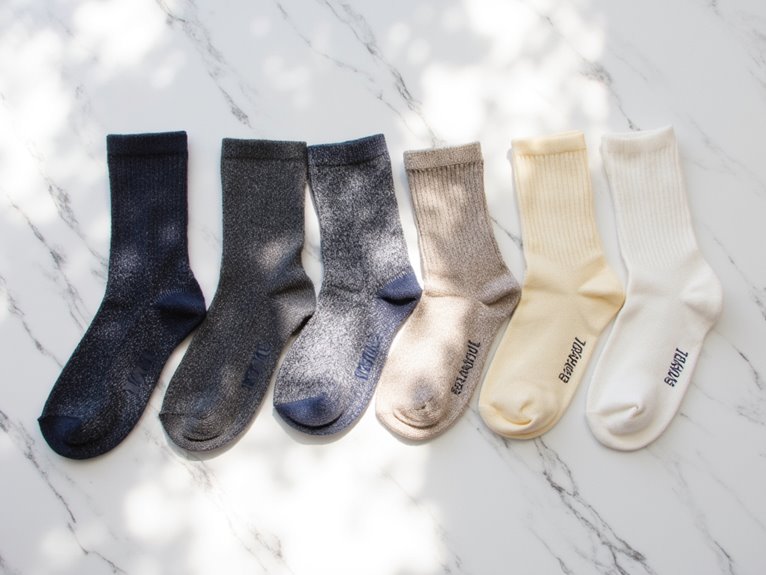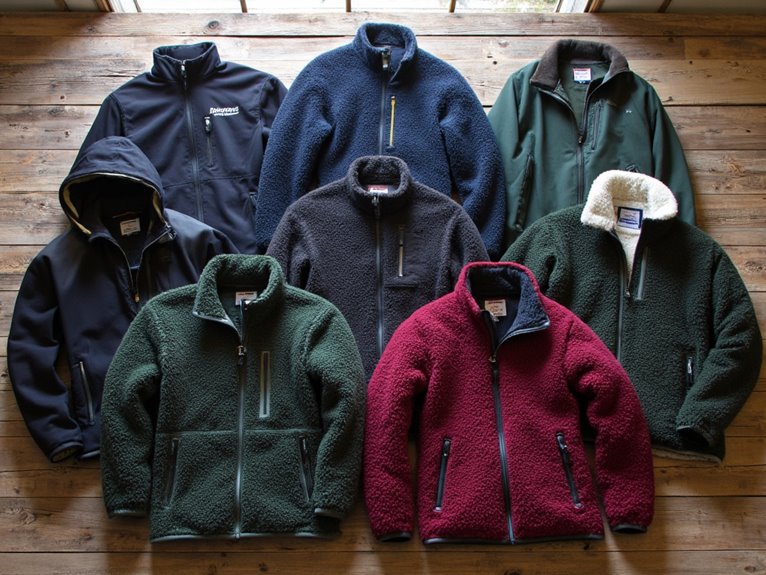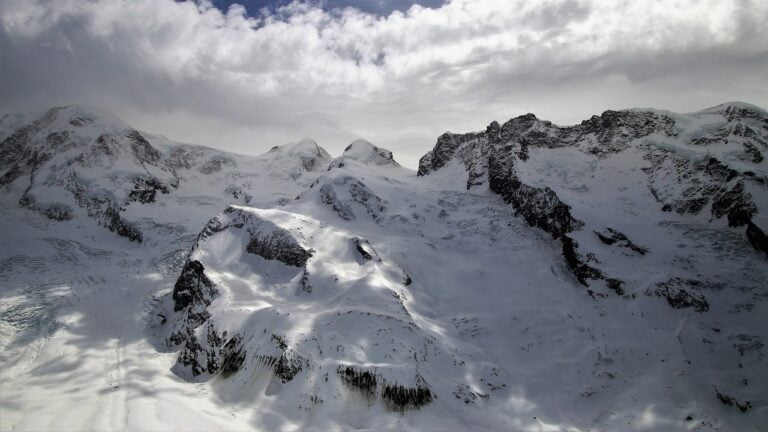10 Best Women’s Sleeping Bags for Backpacking
I’ve tested dozens of women’s sleeping bags across alpine peaks and desert canyons, and the best performers consistently balance three critical factors: temperature ratings that match your intended conditions, weight under 3 pounds for comfortable trail carrying, and insulation type suited to your climate demands. Top picks include the ultralight Sierra Designs Nitro 20° with 800FP DriDown at under 2 pounds, the versatile MARMOT Women’s Teton with 650 fill down for near-freezing temperatures, and the reliable Kelty Cosmic 20° featuring synthetic insulation that performs when wet. The complete breakdown reveals specific technical specifications and performance data for each recommendation.
We are supported by our audience. When you purchase through links on our site, we may earn an affiliate commission, at no extra cost for you. Learn more. Last update on 4th December 2025 / Images from Amazon Product Advertising API.
Notable Insights
- Choose sleeping bags under 3 pounds with compression ratios under 12 inches for optimal backpacking performance and trail comfort.
- Select temperature ratings 10 degrees lower than expected conditions, targeting 30°F to 50°F for three-season backpacking adventures.
- Down insulation offers superior warmth-to-weight ratios, while synthetic insulation maintains effectiveness when wet in damp conditions.
- Look for 800+ fill power down or high-loft synthetic insulation to maximize warmth retention without excessive weight penalties.
- Consider mummy-style bags with features like dual zippers, draft collars, and spacious footboxes for temperature regulation and comfort.
ATEPA Down Sleeping Bag for Adults (650FP Ultralight 3 Season)
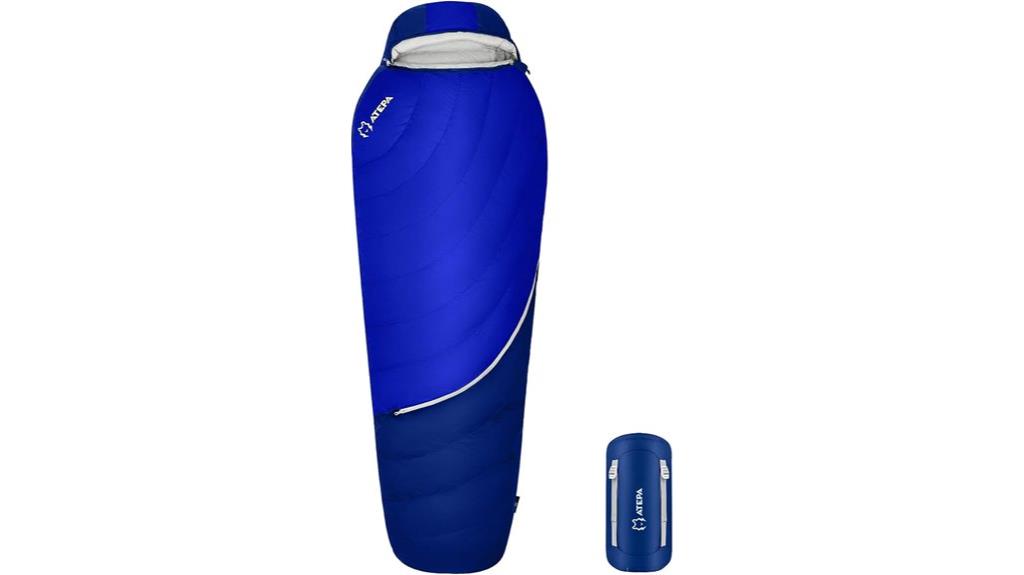
The ATEPA Down Sleeping Bag delivers exceptional warmth-to-weight ratio for female backpackers who prioritize ultralight gear without sacrificing comfort. At just 1.76 pounds, this mummy-style bag features 340g of 90/10 white duck down with 650 fill power. You’ll appreciate the 15D nylon construction that’s both tear-resistant and breathable. The bag’s comfort rating reaches 48.2°F, while its limit extends to 24.8°F for three-season adventures. Its compressed size of 13.78 x 6.69 inches fits easily in your pack. The 3D contoured hood and drawstring closure retain heat effectively. However, you might find the fit snug if you’re taller than average.
Best For: Ultralight backpackers and hikers who need a warm, compact sleeping bag for three-season camping in moderate climates.
Pros:
- Exceptional warmth-to-weight ratio at just 1.76 pounds with 650 fill power down insulation
- Highly packable design compresses to 13.78 x 6.69 inches for easy storage in backpacks
- Durable 15D nylon construction with tear-resistant, breathable fabric and reliable YKK zippers
Cons:
- Snug fit may be uncomfortable for taller individuals or those who prefer more room to move
- Limited temperature range not suitable for extreme cold or hot weather conditions
- Some users report minor issues with zipper operation and occasional fumbles
ECOOPRO Warm Weather Sleeping Bag – Portable & Waterproof for Camping
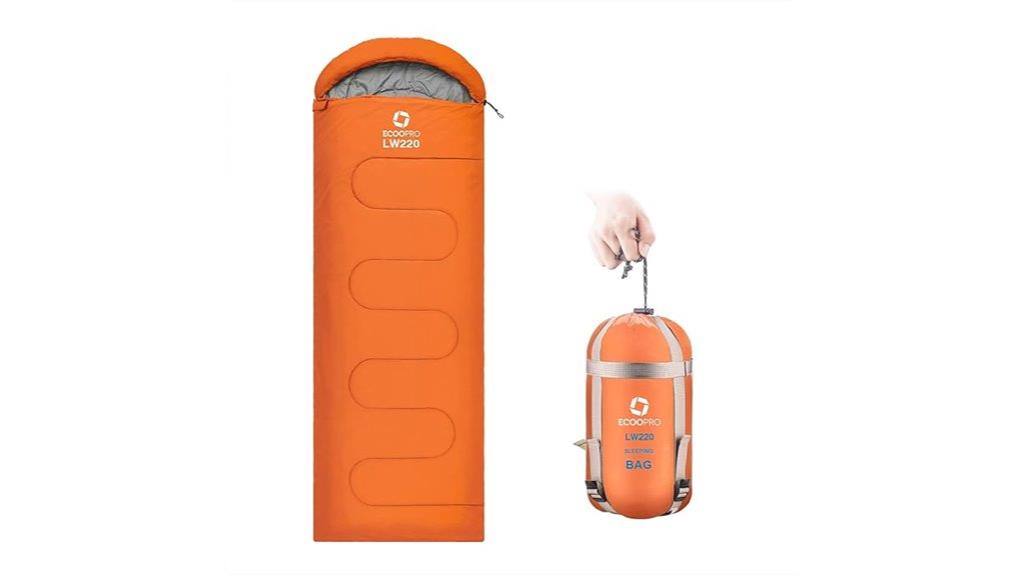
ECOOPRO’s warm weather sleeping bag delivers exceptional value for female backpackers who prioritize lightweight gear without sacrificing comfort or durability. You’ll appreciate its compact 11-inch compressed height and featherlight 1.7-pound weight. The 83L x 30W dimensions accommodate adults comfortably while fitting two children when needed.
The waterproof nylon exterior shields you from moisture, while the 100% polyester lining provides breathable, skin-friendly comfort. You’ll find the 55-60℉ temperature rating perfect for three-season adventures. The smooth zipper operates reliably in field conditions.
This bag’s versatility shines during various weather scenarios. You can remove the liner for adaptability. The integrated compression sack simplifies packing for extended trips. ECOOPRO backs their product with responsive 24-hour customer service for quality concerns.
Best For: Female backpackers and outdoor enthusiasts who need lightweight, compact gear for three-season camping in mild weather conditions.
Pros:
- Ultra-lightweight at 1.7 pounds with compact 11-inch compression size for easy packing
- Waterproof nylon exterior with breathable polyester lining for comfort and weather protection
- Versatile sizing accommodates adults or two children with removable liner for adaptability
Cons:
- Limited temperature range of 55-60℉ restricts use to warm weather conditions only
- May be too narrow at 30 inches width for larger adults or those who prefer more room
- Lacks insulation for cooler temperature camping below 55℉
Kelty Cosmic Synthetic Fill 20 Degree Backpacking Sleeping Bag

Adventurous women seeking reliable warmth in unpredictable conditions will find the Kelty Cosmic Synthetic Fill 20 Degree Backpacking Sleeping Bag delivers exceptional performance through its Cirroloft synthetic insulation system. This mummy-shaped bag weighs 2 pounds 13 ounces and compresses to 16×9 inches in its integrated stuff sack. You’ll appreciate the temperature rating of 20°F, which accommodates sleepers up to 6 feet tall. The ripstop nylon shell provides durability while maintaining packability. Dual-slider zippers offer ventilation control, and the spacious footbox prevents toe compression. Customer reviews consistently praise its warmth retention and field durability, earning 4.5 stars from nearly 500 users across varied backpacking conditions.
Best For: Backpackers and outdoor enthusiasts who need a lightweight, reliable sleeping bag for cold weather conditions down to 20°F and prioritize packability without sacrificing warmth.
Pros:
- Excellent warmth-to-weight ratio with effective Cirroloft synthetic insulation that performs well in damp conditions
- Highly packable design with integrated compression stuff sack reducing to just 16×9 inches for easy transport
- Durable ripstop nylon construction and dual-slider zippers provide long-lasting performance and ventilation control
Cons:
- Snug mummy fit may feel restrictive for larger users or those who prefer more sleeping space
- Can become warm and stuffy without proper ventilation management in milder conditions
- Limited to sleepers up to 6 feet tall, excluding taller individuals from optimal comfort
Lightweight Waterproof Sleeping Bags for Adults Backpacking
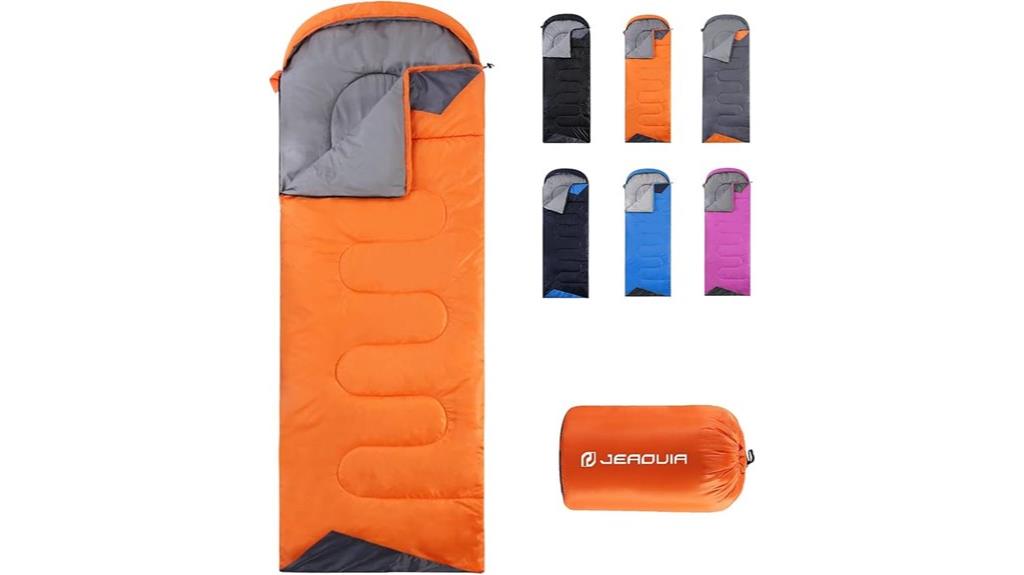
For female backpackers who prioritize three essential qualities in their gear, lightweight waterproof sleeping bags deliver the perfect combination of weather protection, portability, and thermal regulation. These bags feature 190T nylon outer shells that block moisture while maintaining breathability. The polyester pongee lining and hollow cotton fill create effective insulation for temperatures between 50℉-68℉.
You’ll appreciate the practical dimensions: 31.5 inches wide by 86.6 inches deep, accommodating heights up to 5 feet 11 inches. At 3.3 pounds, they compress to just 7.9-14.2 inches for efficient packing. The foot zipper lets you regulate temperature precisely, while the drawstring hood retains warmth during cold nights.
Best For: Female backpackers and hikers up to 5’11” who need lightweight, waterproof sleeping bags for 3-season camping in moderate temperatures between 41℉-77℉.
Pros:
- Lightweight at 3.3 lbs with excellent compression ratio (7.9-14.2 inches) for efficient backpacking
- Waterproof 190T nylon exterior with breathable design prevents moisture buildup while maintaining comfort
- Versatile temperature regulation with foot zipper and drawstring hood for precise thermal control
Cons:
- Limited to 3-season use with temperature range of 50℉-68℉, not suitable for winter camping
- Maximum accommodation height of 5’11” excludes taller users
- Hollow cotton fill may not provide the same warmth-to-weight ratio as premium down insulation
MARMOT Women’s Teton 15° Sleeping Bag, 650 Fill Down
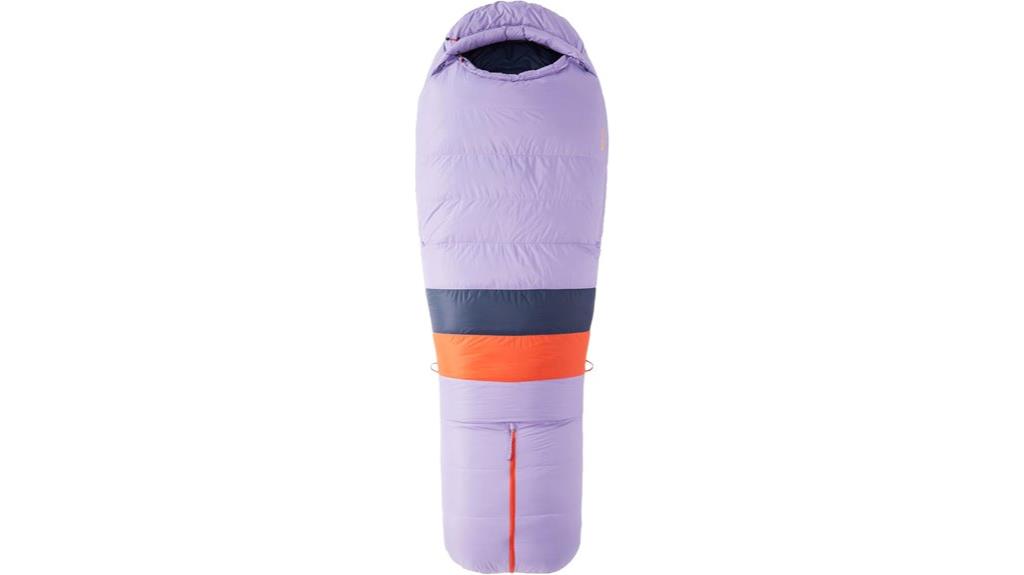
The MARMOT Women’s Teton 15° Sleeping Bag delivers exceptional warmth for female backpackers who encounter near-freezing temperatures during their outdoor adventures. You’ll experience sauna-like heat retention thanks to its 650 fill down insulation and strategic baffling system. The dual side zips let you regulate temperature precisely, while the draft tube and hood prevent heat loss.
You can expect reliable performance in temperatures near 0°C, though it’s not designed for extreme sub-zero conditions. The compressible design packs efficiently, but you’ll want a separate 12-15L dry bag since the included compression sack runs large. While some users report gradual down loss and occasional zipper issues over time, the lightweight construction and superior cold-weather performance make it worthwhile for backpacking trips below 5°C.
Best For: Female backpackers who need reliable warmth in near-freezing temperatures around 0°C and prioritize lightweight, compressible gear for cold-weather camping trips.
Pros:
- Exceptional warmth and heat retention with 650 fill down insulation and strategic baffling system
- Dual side zippers and draft tube allow precise temperature regulation and prevent heat loss
- Lightweight and compressible design makes it ideal for backpacking and easy transport
Cons:
- Gradual loss of down insulation over time affects long-term performance
- Zipper reliability issues with some users experiencing failure after short-term use
- Included compression sack is oversized, requiring a separate 12-15L dry bag for optimal packing
Marmot Women’s Trestles 15° Sleeping Bag (Left-Zip, French Blue/Harbor Blue)

Backpackers venturing into cool, moisture-heavy environments will find the Marmot Women’s Trestles 15° Sleeping Bag engineered specifically for challenging conditions where synthetic insulation outperforms down. The SpiraFil high-loft insulation maintains warmth retention even when wet, unlike down alternatives that lose effectiveness in damp conditions.
You’ll appreciate the practical design features: a full-length two-way zipper for ventilation control and a roomy 3D footbox preventing compression. The wave-construction top maximizes loft while the blanket-construction bottom provides comfort against your sleeping pad.
However, you’ll face portability challenges. Users consistently report difficulty packing this bag into its storage sack due to bulk and weight. The French blue and harbor blue colorway offers visual appeal, though some prefer neutral tones for outdoor gear.
Best For: Backpackers and mountaineers who need reliable warmth in cool, damp conditions and prioritize insulation performance over packability.
Pros:
- SpiraFil synthetic insulation maintains warmth even when wet, unlike down alternatives
- Thoughtful design features including full-length two-way zipper, roomy 3D footbox, and wave-construction top for maximum loft
- Proven performance in challenging environments with positive user feedback on warmth and comfort
Cons:
- Heavy and bulky design makes it difficult to pack into the provided storage bag
- Limited color options may not appeal to users preferring neutral tones for outdoor gear
- Requires adequate sleeping pad for optimal warmth performance
KingCamp Sleeping Bag for Adults, Cold Weather & Waterproof
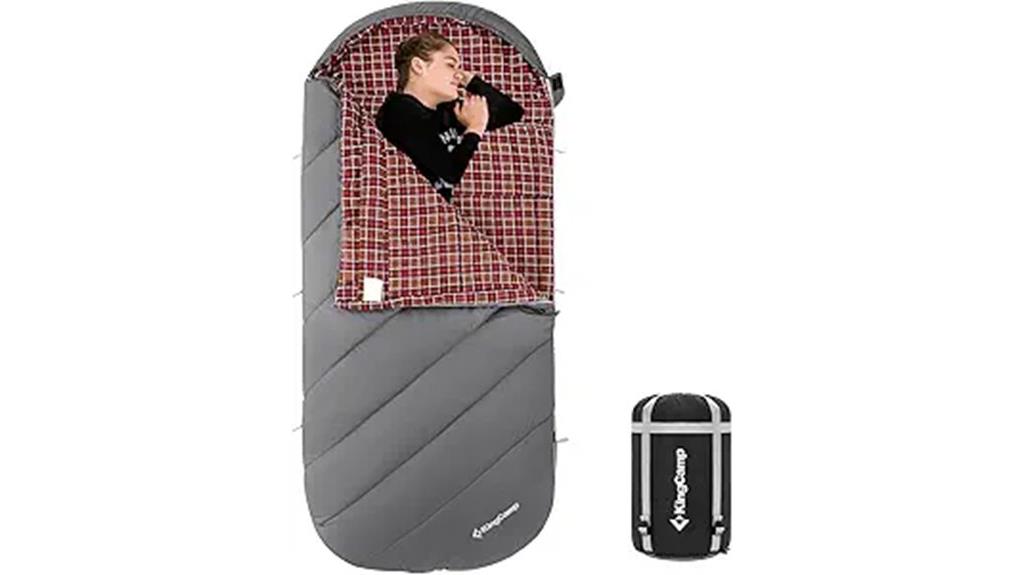
Women seeking a spacious and versatile sleeping solution will find the KingCamp Sleeping Bag delivers exceptional comfort with its generous 86.6 x 39.4-inch dimensions. You’ll appreciate the unrestricted movement this size provides, especially if you’re a restless sleeper. The bag’s 86% cotton and 14% polyester construction features waterproof 210T diamond lattice exterior fabric paired with soft cotton flannel lining. Its 250g hollow fiber filling offers comfort temperatures down to 53.6°F and limit temperatures to 42.8°F. At 4.6 pounds, it packs into a 15 x 9.4-inch compression bag. The full-zip design converts into a blanket for added versatility during 3-season camping adventures.
Best For: Adults who want a spacious, versatile sleeping bag for 3-season camping with the ability to convert into a blanket for couples or solo use in temperatures above 40°F.
Pros:
- Generous dimensions (86.6 x 39.4 inches) provide ample space for movement and comfort for larger adults
- Dual functionality with full-zip conversion to blanket or quilt, plus waterproof exterior with breathable fabric
- Lightweight at 4.6 lbs with compact 15 x 9.4-inch packed size makes it practical for camping and hiking
Cons:
- Limited to warmer weather camping with comfort temperature only down to 53.6°F, not suitable for true cold weather
- Cotton-heavy construction may retain moisture and take longer to dry compared to synthetic alternatives
- Bulkier packed size compared to premium ultralight sleeping bags designed for backpacking
XL Sleeping Bag for 4 Seasons Camping and Hiking (Adults)
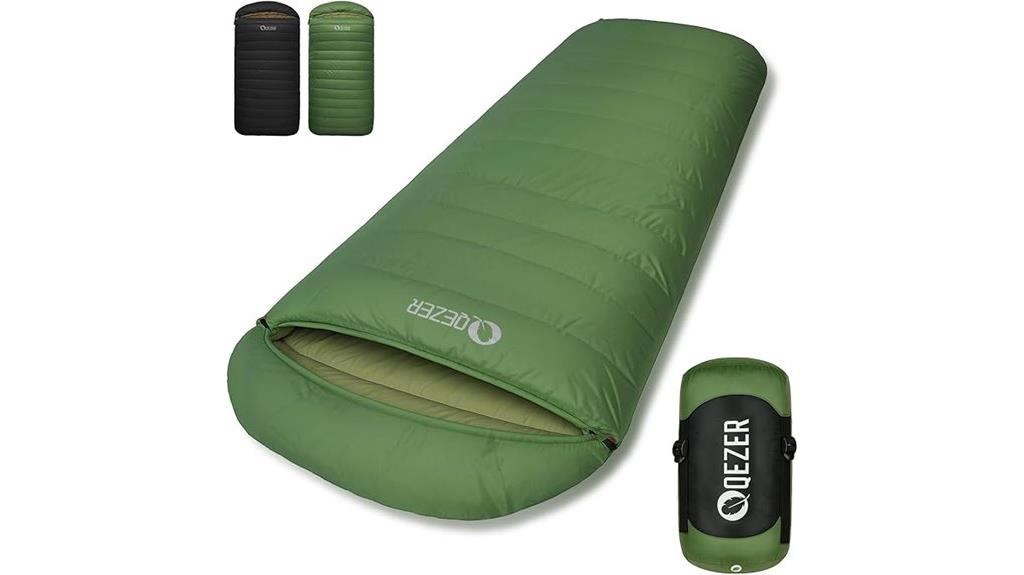
Oversized dimensions make the QEZER XL Sleeping Bag an exceptional choice for taller women who need extra room without sacrificing warmth in four-season conditions. At 90.55 x 39.37 inches, you’ll have ample space while maintaining a lightweight 2-pound profile. The 600FP down fill with 800g insulation provides reliable warmth in temperatures ranging from 28°F to 45°F, with extreme ratings down to 18°F.
You’ll appreciate the 40D high-density nylon exterior that resists tears and moisture. The two-way zipper and hat draw rope enhance cold-weather performance, while internal pockets secure valuables. This bag compresses into a compact size and requires two hours to fully fluff after unpacking.
Best For: Taller adults who need extra space in a lightweight four-season sleeping bag for camping, hiking, and cold-weather outdoor activities.
Pros:
- Oversized dimensions (90.55 x 39.37 inches) provide exceptional space for taller individuals while maintaining ultralight 2-pound weight
- 600FP down insulation with reliable temperature ratings from 28°F to 45°F (extreme down to 18°F) for four-season versatility
- Durable 40D high-density nylon construction with tear and moisture resistance, plus convenient features like two-way zipper and internal pockets
Cons:
- Limited customer review data with only 3 ratings available to assess real-world performance
- Requires 2-hour fluffing time after unpacking from compressed state before achieving full insulation capacity
- Temperature rating may not be sufficient for extreme winter conditions below 18°F without additional insulation layers
Sierra Designs Nitro 20 Degree 800 Fill DriDown Sleeping Bag for Backpacking
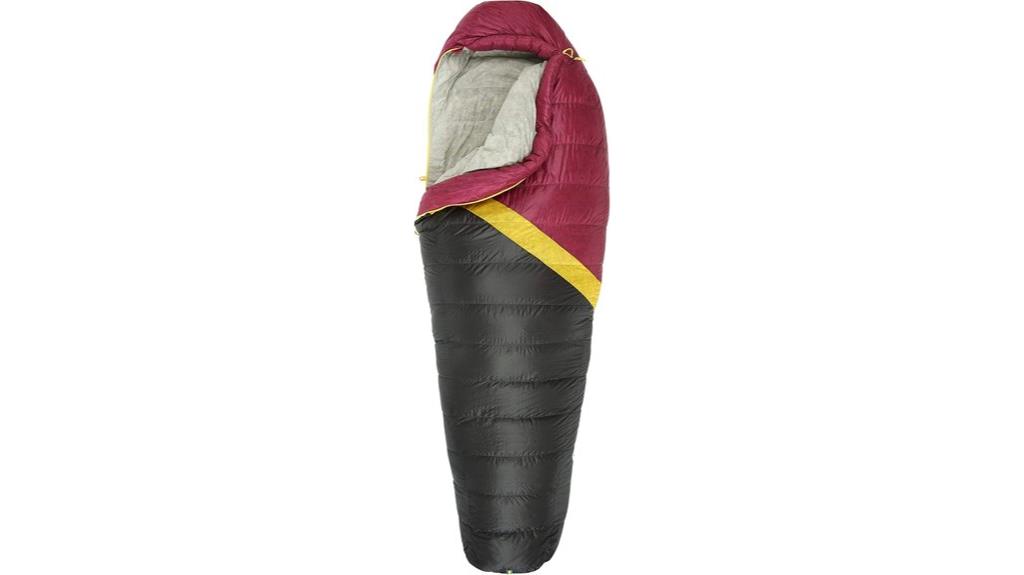
Ultralight adventurers who refuse to compromise warmth for weight will find their ideal match in the Sierra Designs Nitro 20 Degree sleeping bag. Weighing under 2 pounds, it delivers exceptional warmth-to-weight ratio through 800FP PFC-free DriDown insulation and 15d nylon construction.
You’ll appreciate the patented self-sealing foot vent that regulates temperature without heat loss. The draft-dodger collar blocks cold air infiltration, while 5 baffle spacing with side wall baffles maintains consistent insulation distribution. Anti-snag zipper tracks ensure smooth operation in challenging conditions. This bag’s environmentally conscious materials don’t sacrifice performance for sustainability, making it ideal for weight-conscious backpackers requiring reliable three-season protection.
Best For: Ultralight backpackers and weight-conscious adventurers who need reliable three-season warmth without compromising on portability.
Pros:
- Exceptional warmth-to-weight ratio at under 2 pounds with 800FP DriDown insulation
- Innovative temperature regulation features including patented self-sealing foot vent and draft-dodger collar
- Environmentally friendly PFC-free materials that maintain high performance standards
Cons:
- 20-degree rating limits use to three-season camping, not suitable for winter conditions
- Premium 800FP down insulation likely comes with a higher price point
- Ultralight 15d nylon construction may be less durable than heavier fabrics
MARMOT Voyager 45° or 55° Mummy Sleeping Bags
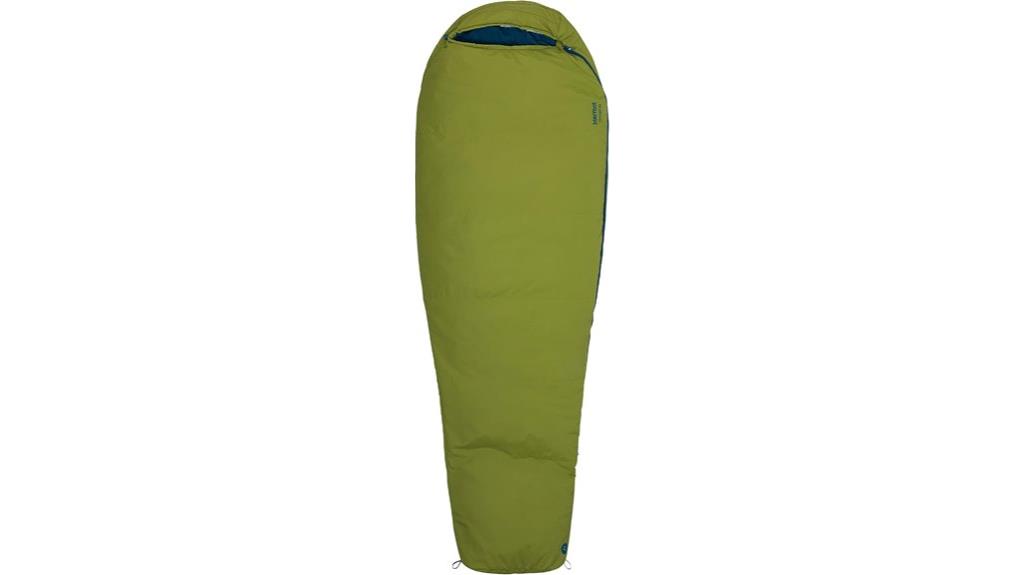
Backpackers seeking reliable warmth without excessive weight will find the MARMOT Voyager 45° or 55° Mummy Sleeping Bags deliver exceptional performance for three-season adventures. These bags utilize SpiraFil high-loft synthetic insulation for consistent warmth retention. The 50D polyester shell construction provides durability while maintaining compressibility.
You’ll appreciate the practical specifications: regular size weighs 1 pound, 8 ounces with 167.8 cubic inches pack volume and 84-inch interior length. Long size adds 4 ounces, expanding to 200.2 cubic inches and 90-inch length. The full-length YKK two-way zipper locks securely and enables precise ventilation control. PFAS-free materials eliminate harmful chemical exposure during extended outdoor use.
Best For: Backpackers and campers who need a lightweight, compressible sleeping bag for three-season use in temperatures down to 45° or 55°F.
Pros:
- Lightweight design at just 1 lb 8 oz for regular size with excellent compressibility for backpacking
- SpiraFil synthetic insulation provides reliable warmth retention even when wet, unlike down alternatives
- PFAS-free materials ensure safer outdoor use without harmful chemical exposure
Cons:
- Temperature ratings of 45° and 55°F limit use to warmer conditions, not suitable for cold weather camping
- Synthetic insulation typically offers lower warmth-to-weight ratio compared to premium down sleeping bags
- Mummy shape may feel restrictive for sleepers who prefer more room to move around
Factors to Consider When Choosing Women’s Sleeping Bags for Backpacking
When I help you select a women’s backpacking sleeping bag, five critical factors determine whether you’ll stay warm and comfortable on the trail. Your temperature rating choice directly affects your safety and sleep quality, while weight and packability impact how much gear you can carry during long hikes. I’ll guide you through insulation types, proper fit considerations, and material durability so you can make an informed decision that matches your specific backpacking needs.
Temperature Rating Selection
Temperature rating serves as your primary compass for selecting a women’s sleeping bag that’ll keep you comfortable throughout the night. Understanding the three rating categories is essential. Comfort ratings indicate temperatures where you’ll sleep comfortably without feeling cold. Limit ratings mark the lowest temperature most users can tolerate. Extreme ratings represent survival thresholds, not comfort zones.
For three-season backpacking, I recommend bags rated between 30°F and 50°F. Summer trips require higher ratings above 50°F for proper ventilation. Winter expeditions demand bags rated 0°F or below.
Consider your insulation preference carefully. Down provides superior warmth-to-weight ratios but loses effectiveness when wet. Synthetic fills maintain insulation properties in humid conditions. Match your bag’s rating to expected nighttime lows, adding a 10-degree buffer for safety.
Weight and Packability
Beyond temperature considerations, weight becomes your next critical decision factor when selecting a women’s sleeping bag for backpacking. I recommend targeting bags under 3 pounds for ideal trail performance. Every ounce matters during multi-day treks.
Ultralight options weighing 1.5 to 2 pounds offer the best weight savings without sacrificing essential warmth. High-density nylon shells and specialized synthetic fills provide excellent durability while maintaining minimal weight.
Packability proves equally important as weight. Look for bags compressing to less than 12 inches in height when stuffed. This compact size maximizes your backpack’s available space for other gear.
Focus on weight-to-warmth ratios when comparing options. A well-engineered bag balances insulation properties with portability requirements, ensuring you stay warm without carrying unnecessary bulk on challenging trails.
Insulation Type Comparison
Although weight matters considerably, your choice of insulation determines both performance and reliability throughout your backpacking adventures. Down insulation offers superior warmth-to-weight ratios and exceptional compressibility. Premium down bags feature 800FP or higher, delivering maximum performance in cool, dry conditions. However, down loses insulating properties when wet.
Synthetic insulation, typically polyester-based materials like Cirroloft, retains heat even when saturated. These bags cost less and perform better in humid environments. Synthetic options require more space in your pack but offer consistent warmth regardless of moisture exposure.
Women’s-specific bags enhance both insulation types through strategic placement. Additional insulation around your core areas compensates for physiological differences in heat distribution. Down excels for lightweight alpine conditions, while synthetic insulation suits wet climates and budget-conscious backpackers.
Fit and Sizing
How can proper fit transform your backpacking sleep system from uncomfortable to restorative? Women’s sleeping bags feature contoured shapes specifically designed for female physiques. These designs accommodate wider hips and busts while maintaining thermal efficiency through snug-fitting torso sections.
I recommend checking three key measurements: overall length, shoulder width, and hip circumference. Most women’s models accommodate users up to 6 feet tall with adjustable features. The shoulder measurement should allow comfortable arm movement without excess space that creates cold spots. Hip dimensions must provide adequate room while preventing heat loss.
A properly fitted bag functions like a second skin. Too loose compromises warmth retention. Too tight restricts movement and compresses insulation. Many women’s designs include enhanced insulation in footboxes and hoods, addressing specific areas where women typically lose heat during sleep.
Material and Durability
Three critical material factors determine whether your sleeping bag survives multiple seasons of rugged backpacking. First, fabric choice matters greatly. Nylon and polyester shells provide essential water resistance and tear protection against sharp branches and rocky terrain. I recommend selecting higher denier fabrics like 15D or 50D for superior abrasion resistance and longevity.
Second, insulation type affects both performance and durability. Down insulation offers excellent warmth-to-weight ratios but loses effectiveness when wet. Synthetic fills maintain insulating properties in damp conditions, making them more reliable for unpredictable weather.
Third, construction quality determines long-term performance. Quality baffle designs prevent cold spots and maintain insulation loft over time. Look for reinforced stitching at stress points and weatherproofing features that promote consistent performance across varying climates and conditions.
Price Vs Performance
Understanding these material considerations sets the foundation for making smart purchasing decisions about price versus performance. Higher-priced sleeping bags typically deliver superior insulation, durability, and packability features that justify their cost. Quality insulation materials like down or synthetic fill command premium prices but provide better warmth-to-weight ratios essential for multi-day trips.
Cost-effective options often lack advanced features such as moisture resistance or efficient compression systems. This makes them heavier and bulkier to carry. Investing in well-reviewed sleeping bags yields better long-term value since expensive options withstand varied environmental conditions, reducing replacement frequency.
I recommend choosing bags with temperature ratings suited to different seasons. This minimizes purchasing multiple sleeping bags while offering better performance across diverse scenarios, keeping overall costs down.
Frequently Asked Questions
How Do I Properly Clean and Maintain My Women’s Sleeping Bag?
I’ll wash your sleeping bag in a front-loading machine with gentle detergent, then air dry it completely. I’d spot clean minor stains and store it uncompressed to maintain loft and insulation properties.
What’s the Difference Between Temperature Rating and Comfort Rating for Sleeping Bags?
Temperature rating indicates the lowest temperature where you’ll survive, while comfort rating shows where you’ll actually sleep well. I recommend choosing based on comfort rating since it reflects realistic sleeping conditions rather than just survival temperatures.
Can I Use a Women’s Sleeping Bag if I’m a Man?
I’d say absolutely, you can use a women’s sleeping bag as a man. The main differences are cut and insulation placement, but if it fits comfortably and keeps you warm, it’ll work perfectly fine.
How Do I Repair a Tear or Broken Zipper in My Sleeping Bag?
I’ll show you how to fix tears and zippers. For tears, use fabric patches with seam sealer or duct tape temporarily. For broken zippers, try lubricating with soap or replace the slider completely.
What Sleeping Pad Works Best With Women’s Specific Sleeping Bags?
I’d recommend choosing a sleeping pad that matches your bag’s width and insulation needs. Women’s bags often pair well with wider pads for comfort, plus R-value ratings that complement your bag’s temperature rating.
On a final note
I’ve outlined eight top-performing women’s sleeping bags that deliver reliable warmth and packability for backpacking. Your choice depends on three key factors: temperature rating, fill type, and weight requirements. Down bags offer superior warmth-to-weight ratios but lose insulation when wet. Synthetic fills maintain warmth in moisture but weigh more. Match your bag’s comfort rating to expected nighttime lows, then prioritize pack weight versus durability based on your backpacking style.

